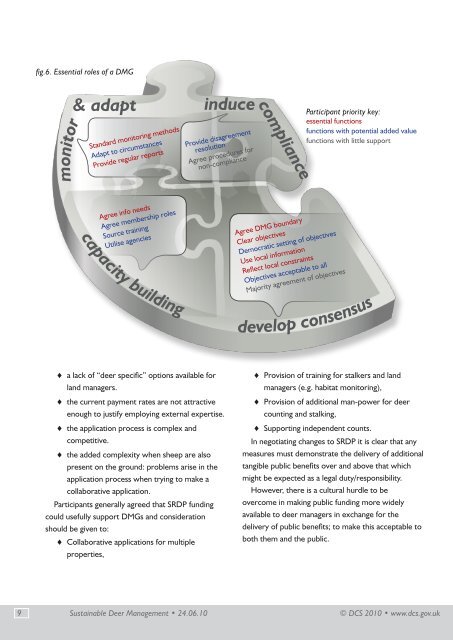Sustainable Deer Management A Case Study Report for the Deer ...
Sustainable Deer Management A Case Study Report for the Deer ...
Sustainable Deer Management A Case Study Report for the Deer ...
You also want an ePaper? Increase the reach of your titles
YUMPU automatically turns print PDFs into web optimized ePapers that Google loves.
fig.6. Essential roles of a DMG<br />
monitor<br />
& adapt<br />
Standard monitoring methods<br />
Adapt to circumstances<br />
Provide regular reports<br />
induce<br />
Provide disagreement<br />
resolution<br />
Agree procedures <strong>for</strong><br />
non-compliance<br />
compliance<br />
Participant priority key:<br />
essential functions<br />
functions with potential added value<br />
functions with little support<br />
Agree info needs<br />
Agree membership roles<br />
Source training<br />
Utilise agencies<br />
capacity building<br />
Agree DMG boundary<br />
Clear objectives<br />
Democratic setting of objectives<br />
Use local in<strong>for</strong>mation<br />
Reflect local constraints<br />
Objectives acceptable to all<br />
Majority agreement of objectives<br />
develop consensus<br />
♦♦<br />
a lack of “deer specific” options available <strong>for</strong><br />
land managers.<br />
♦♦<br />
<strong>the</strong> current payment rates are not attractive<br />
enough to justify employing external expertise.<br />
♦♦<br />
<strong>the</strong> application process is complex and<br />
competitive.<br />
♦♦<br />
<strong>the</strong> added complexity when sheep are also<br />
present on <strong>the</strong> ground: problems arise in <strong>the</strong><br />
application process when trying to make a<br />
collaborative application.<br />
Participants generally agreed that SRDP funding<br />
could usefully support DMGs and consideration<br />
should be given to:<br />
♦♦<br />
Collaborative applications <strong>for</strong> multiple<br />
properties,<br />
♦♦<br />
Provision of training <strong>for</strong> stalkers and land<br />
managers (e.g. habitat monitoring),<br />
♦♦<br />
Provision of additional man-power <strong>for</strong> deer<br />
counting and stalking,<br />
♦♦<br />
Supporting independent counts.<br />
In negotiating changes to SRDP it is clear that any<br />
measures must demonstrate <strong>the</strong> delivery of additional<br />
tangible public benefits over and above that which<br />
might be expected as a legal duty/responsibility.<br />
However, <strong>the</strong>re is a cultural hurdle to be<br />
overcome in making public funding more widely<br />
available to deer managers in exchange <strong>for</strong> <strong>the</strong><br />
delivery of public benefits; to make this acceptable to<br />
both <strong>the</strong>m and <strong>the</strong> public.<br />
9 <strong>Sustainable</strong> <strong>Deer</strong> <strong>Management</strong> • 24.06.10 © DCS 2010 • www.dcs.gov.uk
















